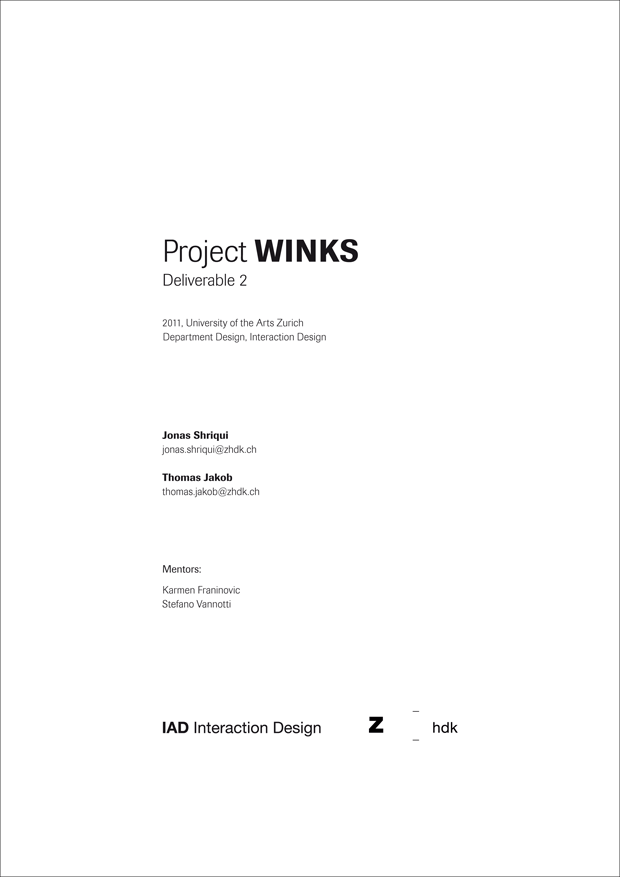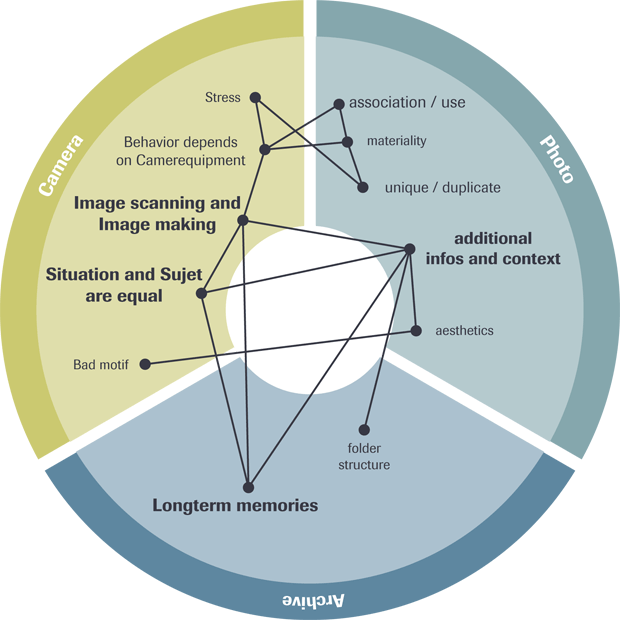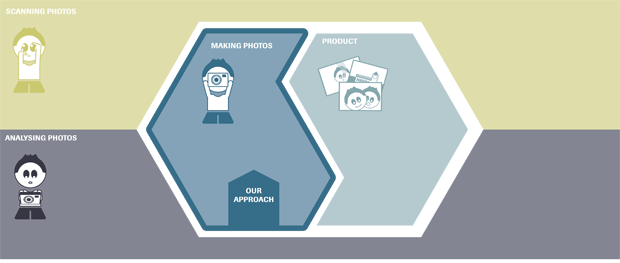Background (cuma360)
Background (cuma360) | Deliverable

––––––––––––––––––––––––––––––––––––––––––––––––––––––––––––––––––––––––––––––––––––––––
Background (cuma360) | Conclusion

During our research we found, that the process of photographing can essentially be reduced to three areas: the camera, the photograph as object and the photo archive. We found texts with interesting thoughts in each of these three areas. Many of these approaches centered on the theme "enriching photos with Context" and the "the act of photography”. To summarize the research visually, we created a graphic from our findings. When analyzing the graphic, we realized that we need to work on the camera. This approach allows us to influence all three areas. We summarized our results in a question: How can we make the act of photography a real experience again? This question was too general and imprecise us! Therefore, we defined a new question, but their impact also relates to the first question:
"How can the user capture the situation while taking the photo?"

––––––––––––––––––––––––––––––––––––––––––––––––––––––––––––––––––––––––––––––––––––––––
Background (cuma360) | Bibliography
Frens, J. W. (2006). Designing for Rich Interaction: Integrating Form, Interaction, and Function. JF Schouten School for User-System Interaction Resarch. Eindhoven : Technische Universiteit.
Helck, P., & Riewe, E. (2006). Ein Leben in Fotografien. In I. Ziehe, & U. Hägele, Fotos – "schön und nützlich zugleich" (S. 129-142). Münster: LIT Verlag Berlin.
Holschbach, S. (2009). Fotokritik in Permanenz. Flickr als praktische Bildwissenschaft. In I. Ziehe, & U. Hägele, Digitale Fotografie – Kulturelle Praxen eines neuen Mediums (Bd. 4, S. 77-84). München: Waxmann Verlag GmbH.
Köstlin, K. (2006). Der Liebe Blick – Kinderfotografie. In I. Ziehe, & U. Hägele, Fotos – "schön und nützlich zugleich" (S. 19-28). Münster: LIT Verlag Berlin.
Klaassen Nägeli, S. (2006). Private Fotos: Exponate im Museum der Lebensgeschichten. In I. Ziehe, & U. Hägele, Fotos – "schön und nützlich zugleich" (S. 237-250). Münster: LIT Verlag Berlin.
Mathys, N. (2006). “Herumverschenken, austauschen, sammeln – was man mit Fotos halt so macht.” Automatenfotos im Dienste der Freundschaft. In I. Ziehe, & U. Hägele, Fotos – "schön und nützlich zugleich" (S. 251-266). Münster: LIT Verlag Berlin.
Metz, C. (2011). Photography and Fetish. The MIT Press.
Moder, C. (28. 12 2010). Warum sollte man fotografieren? Abgerufen am 16. 2 2011 von Warum sollte man fotografieren?: http://www.christoph-moder.de/hobbies/fotografie/warum.php
Sachsse, R. (2009). Zur Zukunft der Erinnerung. In I. Ziehe, & U. Hägele, Digitale Fotografie – Kulturelle Praxen eines neuen Mediums (Bd. 4, S. 13-22). München: Waxmann Verlag GmbH.
Santaella, L. (2009). Flüchtige Bilder. In P. Seibert, & W. Nöth, Intervalle 12– Schriften zur Kulturforschung (S. 19-38). Kassel: kassel university press GmbH.
Schamberg, G. L. (2009). Der virtuelle Knipser und seine digitalen Bilder im StudiVZ. Eine Fallstudie. In I. Ziehe, & U. Hägele, Digitale Fotografie – Kulturelle Praxen eines neuen Mediums (Bd. 4, S. 119-130). München: Waxmann Verlag GmbH.
Scheiter, B. (2009). Ist das noch Fotografie? Analog / Digital: Ein Versuch der Vergleichs zweier Techniken und ihrer Nomenklatur. In I. Ziehe, & U. Hägele, Digitale Fotografie – Kulturelle Praxen eines neuen Mediums (Bd. 4, S. 39-46). München: Waxmann Verlag GmbH.
Schuster, M. (2005). Fotos sehen, verstehen, gestalten. Berlin: Springer.
Wikipedia. (16. 2 2011). wikipedia.org/wiki/Lomografie. Abgerufen am 16. 2 2011 von wikipedia.org: http://de.wikipedia.org/wiki/Lomografie
Wikipedia. (22. 1 2011). wikipedia.org/wiki/Polaroid. Abgerufen am 16. 2 2011 von wikipedia.org: http://de.wikipedia.org/wiki/Polaroid
Ziehe, I., & Hägele, U. (2009). Digitale Fotografie – Kulturelle Praxen eines neuen Mediums (Bd. 4). München: Waxmann Verlag GmbH.
Ziehe, I., & Hägele, U. (2006). Vorab: Objekt Fotografie. In I. Ziehe, & U. Hägele, Fotos – "schön und nützlich zugleich" (S. 1-4). Münster: LIT Verlag Berlin.

 During our research we found, that the process of photographing can essentially be reduced to three areas: the camera, the photograph as object and the photo archive. We found texts with interesting thoughts in each of these three areas. Many of these approaches centered on the theme "enriching photos with Context" and the "the act of photography”. To summarize the research visually, we created a graphic from our findings. When analyzing the graphic, we realized that we need to work on the camera. This approach allows us to influence all three areas. We summarized our results in a question: How can we make the act of photography a real experience again? This question was too general and imprecise us! Therefore, we defined a new question, but their impact also relates to the first question:
"How can the user capture the situation while taking the photo?"
During our research we found, that the process of photographing can essentially be reduced to three areas: the camera, the photograph as object and the photo archive. We found texts with interesting thoughts in each of these three areas. Many of these approaches centered on the theme "enriching photos with Context" and the "the act of photography”. To summarize the research visually, we created a graphic from our findings. When analyzing the graphic, we realized that we need to work on the camera. This approach allows us to influence all three areas. We summarized our results in a question: How can we make the act of photography a real experience again? This question was too general and imprecise us! Therefore, we defined a new question, but their impact also relates to the first question:
"How can the user capture the situation while taking the photo?"
